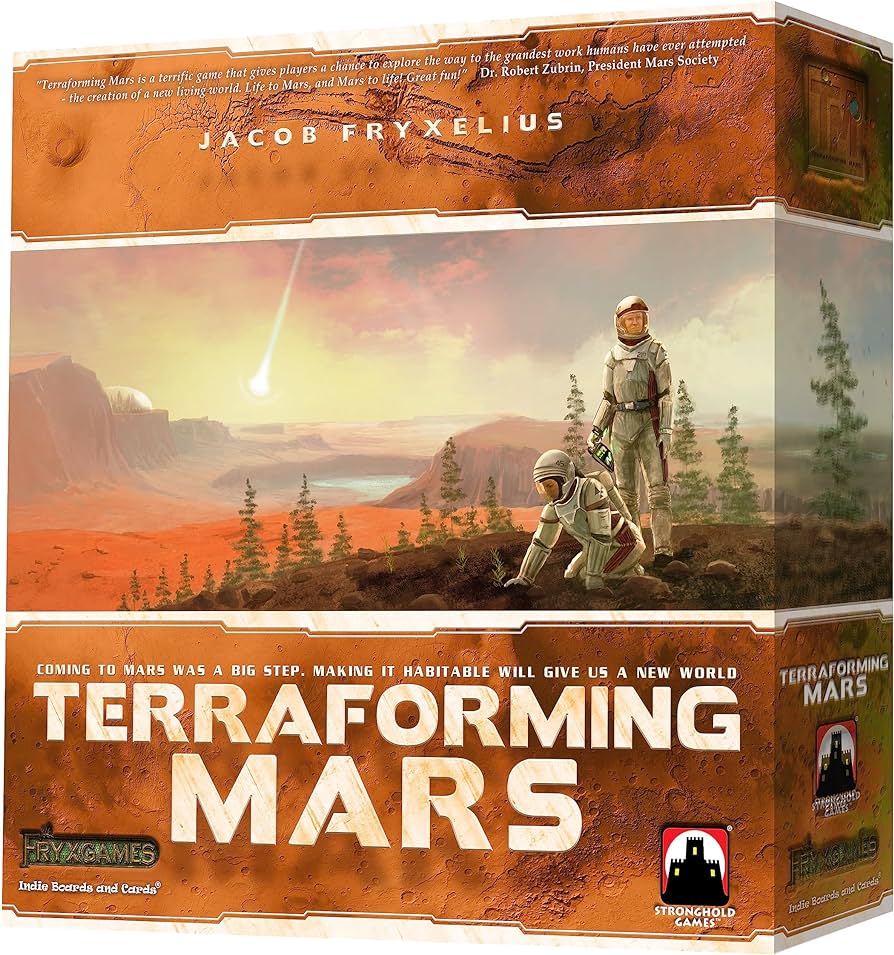Terraforming Mars Review
Terraforming Mars stands out as a game centered on resource management, strategic planning, and adaptability. It simulates the process of making Mars habitable over multiple rounds, requiring players to strategically allocate resources and balance short-term needs with long-term goals. With over 200 unique project cards, players must optimize resource production and build robust corporate engines. The game’s complexity and multi-faceted approach provide a richly rewarding experience.
Terraforming Mars Gameplay Overview
The gameplay in Terraforming Mars unfolds over a series of rounds, each representing stages in making the red planet habitable. The core mechanism revolves around resource management. Players must allocate resources strategically to terraform Mars, represented visually on the game board.
Throughout the game, I draw cards that represent various projects and technologies, which I can use to increase my production capabilities, enhance resource gathering, or even construct infrastructure on the Martian surface. These cards are crucial in shaping my overall strategy, as they provide the necessary tools to overcome the planet’s harsh environment. The gameplay is divided into phases, each representing a specific stage of terraforming. During each phase, I must manage my resources carefully, balancing the need to produce resources with the need to make progress on the terraforming process.
As the game progresses, the challenges escalate, and I must adapt my strategy to overcome the obstacles that arise. With each round, I’m faced with difficult decisions that impact the fate of Mars and its future habitability. The game’s complexity is both engaging and intimidating, making Terraforming Mars a thrilling experience that demands careful planning and strategic thinking.
Mastering Corporate Management
Building a robust corporate engine is key to success in Terraforming Mars. This aspect of the game requires a delicate balance of resource management and strategic planning.
Key Elements of Corporate Management
- Resource Management: Mega credits, steel, titanium, power, and plants must be managed efficiently to play cards and take actions.
- Production Optimization: Boosting resource production through card play enables more actions and a stronger corporate engine.
- Strategic Adaptation: Balancing short-term needs with long-term goals, players must adapt to changing circumstances and opponents’ actions.
Mastering corporate management requires deep understanding of game mechanics, strategic planning, and adaptability, driving players towards victory.
Terraforming the Red Planet
Terraforming Mars involves making the planet habitable by achieving specific parameters: 14% oxygen levels, a temperature of 8°C, and nine ocean tiles. This multi-faceted process requires careful planning and strategic execution.
Core Objectives
- Increasing Terraforming Parameters: Higher oxygen levels and temperatures enhance resource production and card play options.
- Diverse Economy: Combining resource production with strategic card play helps adapt to the evolving game state.
- Greenery Tiles: Planting and strategically placing Greenery tiles increases oxygen levels and maximizes resources.
The game’s scientific accuracy and attention to detail demand careful resource management and strategic card play, highlighting the complexity of terraforming Mars.
Game Mechanics and Components
Terraforming Mars features meticulously designed mechanics and high-quality components that simulate the complexities of terraforming a planet.
Game Mechanics
- Engine-Building Mechanism: Players manage resources to create a livable environment on Mars.
- Project Cards: Over 200 unique cards with specific requirements and effects allow for varied strategies.
- Terraforming Tracks: Oxygen, temperature, and ocean coverage tracks guide the terraforming process.
- Player Boards: Each player manages resources, including mega credits, steel, titanium, power, and plants, and takes actions such as playing cards and funding awards.
Component Quality
- Player Mats and Cards: High-quality materials enhance the tactile experience.
- Visual Design: Stunning card art and detailed game boards make the game visually appealing.
Effective resource management and strategic allocation are essential, making Terraforming Mars an immersive and engaging game.
Pros and Cons of Terraforming Mars
While Terraforming Mars shines with its engaging gameplay and high replayability, it’s not without its drawbacks, and a closer examination of its pros and cons reveals a more nuanced understanding of this complex game.
As a player, I’ve found that the game’s component quality is inferior compared to other board games like Scythe. The low-quality player boards and plastic cubes can chip off, affecting the overall gameplay experience. In addition, the engine-building mechanism can be intimidating, requiring a combination of tactical play and long-term strategic planning. This complexity can be intimidating for some players.
Another drawback is the lack of a catch-up mechanic, which can make it difficult for lagging players to recover, leading to a less engaging experience for those who fall behind. Furthermore, analysis paralysis can be a problem, especially with the drafting mechanism, which can lead to decision-making difficulties and slower gameplay.
Despite its drawbacks, Terraforming Mars offers a richly rewarding experience with high replayability. Its unique mechanics and strategic depth make it a standout in the world of board games.
We are supported by our audience. When you purchase through links on our site, we may earn an affiliate commission, at no extra cost for you. Learn more.

